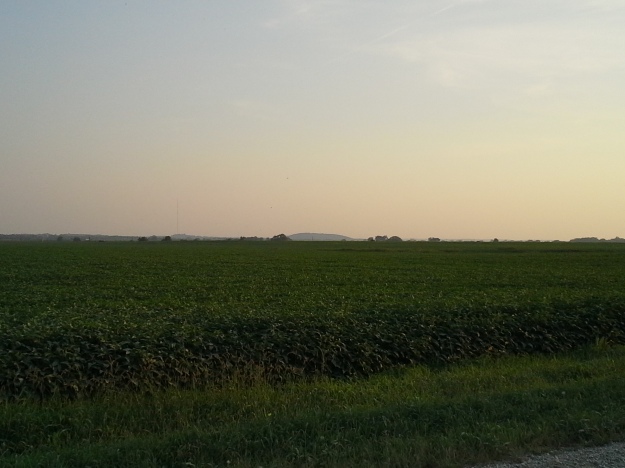“See that big boulder over there?” My then-boyfriend, now-husband, Jim, pointed to a large rock with a small bronze rectangle on it. It was in the spring of 2000, during one of my visits to Emporia before I packed up my meager belongings and left L.A. for good. We were driving through the old Maplewood section of Memorial Lawn Cemetery.
“The story goes that Preston B. Plumb, one of early Emporia’s important citizens, was having an affair with a woman in Colorado. Supposedly, his wife caught Preston with his mistress, right on that very rock. When he died, Mrs. Plumb had that rock hauled all the way back to Emporia, planted it smack on top of his grave, and said, ‘That ought to keep the SOB down.'”
—
Each year, around the end of July and the beginning of August, Kansas is hit with the most hideous and humid weather. Temperatures reach the triple digits, with a humidity pushing the heat index to 110 or 115 degrees. Our air conditioners can barely keep up, but at least we have air conditioners. A hundred years ago, Kansans had two options: if you were poor, you stayed around and suffered. If you were at least a little well-to-do, you hopped the train and headed for the cooler air of Colorado.
Such was the case of the Plumb family. Preston B. Plumb was, in fact, an important Emporian. Emporia State University’s oldest and most prominent building bears his name. His house, Plumb Place, still serves as a well-respected residence for low-income women. And so, when the heat of summer settled over Emporia like a smothering wet towel, the Plumb family packed their bags and headed west.
—
“So I had that stone shipped back to Emporia and hand it placed right on top of his grave. That ought to keep that man down!” It was living history day at the cemetery, and a university theater major, dressed as Mrs. Plumb, told the story of the Plumb rock as the crowd roared with laughter.
“Now wait just a doggone minute!” a shout came out over the still chuckling crowd. “Where did you get that history?”
The girl, taken aback, looked at the balding man with the closely cropped white beard. “The historical society,” she said.
The naysayer wasn’t just any naysayer; he was Bob Hodge, a man who has spent his retired years reading every available microfilmed issue of all 44 Lyon County newspapers then indexing their contents. The crowd parted, turning their attention to the man in the short-sleeved plaid shirt.
“The rock,” he said, “was from Colorado. But that’s because the Plumbs went to Colorado over the summers. And this rock came from one of their favorite spots. So when he died, his wife had this rock brought back for their plot. That’s why this rock doesn’t look like the other rocks in this cemetery. It isn’t native. The story about the affair isn’t true.”
After hearing Bob Hodge’s story, the crowd departed. The truth wasn’t nearly as interesting as the legend.
—
Still, the legend has legs in Emporia; its one of a handful of stories newcomers interested in history hear, following how Emporia became the county seat (supposedly, men stole the books from the territorial county seat in Americus), the Sandy Bird/Marty Anderson murders, and the legend of the brewery in a cave next to the university campus. Yet I couldn’t find it documented on paper anywhere, and a google search brought up another wonderful Plumb legend: that of the curse of the Wyandot Indians. Apparently, Preston B. Plumb argued the ancient Huron Cemetery in Kansas City, Kansas should be razed and sold for land; he dropped dead a year later.
Despite there being at least a dozen other large stones used as family markers throughout the cemetery, the Plumb rock continues to garner the most attention. One part of the legend cannot be true; Preston has his own marker nearby, just as the other Plumbs do – meaning the boulder isn’t planted on his chest.
Emporia is finally cooling down; 100 years ago, the Plumbs and others would be en route to Emporia right now. Plumb had no idea that despite helping found a town, despite being a U.S. Senator, despite his work as a Kansas legislator, he would be better known for betraying his wife and stomping on a Native American tribe.
But without the legends, would he just be a name on a building and a rock?

The famous Plumb rock in the old Maplewood Section of Memorial Lawn Cemetery in Emporia, Kansas.



